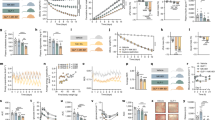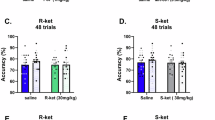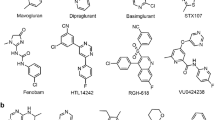Abstract
Pharmacological manipulation of N-methyl-D-aspartate (NMDA) receptors may be critical for the treatment of many neurological and psychiatric disorders. Metabotropic glutamate (mGlu5) receptors are abundant in corticolimbic circuitry, where they modulate NMDA receptor-mediated signal transduction. Therefore, pharmacological manipulation of mGlu5 receptor may provide a treatment strategy for cognitive disorders that are associated with NMDA receptor dysfunction. We sought to determine whether the recently described molecular and cellular interactions between NMDA and mGlu5 receptors coregulate higher order behaviors. We examined the interaction of the selective mGlu5 receptor antagonist, 2-methyl-6-(phenylethynyl)-pyridine (MPEP), and the use-dependent NMDA antagonist MK-801, on locomotion, stereotypy, working memory, instrumental learning, and corticolimbic dopamine release. MPEP, at 10 mg/kg, but not 3 mg/kg, impaired working memory and instrumental learning, transiently increased dopamine release in prefrontal cortex and nucleus accumbens, and augmented the effect of MK-801 on cortical dopamine release, locomotion, and stereotypy. Pretreatment with 3 mg/kg of MPEP enhanced the detrimental effects of MK-801 on cognition. These results demonstrate that an mGlu5 receptor antagonist can potentiate the motoric, cognitive, and dopaminergic effects of an NMDA receptor antagonist. Thus, mGlu5 receptors appear to play a major role in regulating NMDA receptor-dependent cognitive functions such as learning and working memory. By extension, these results suggest that pharmacological potentiation of mGlu5 receptors may ameliorate the cognitive and other behavioral abnormalities associated with NMDA receptor deficiency.
Similar content being viewed by others
Log in or create a free account to read this content
Gain free access to this article, as well as selected content from this journal and more on nature.com
or
References
Adams B, Moghaddam B (1998). Corticolimbic dopamine neurotransmission is temporally dissociated from the cognitive and locomotor effects of phencyclidine. J Neurosci 18: 5545–5554.
Adams BW, Moghaddam B (2001). Effect of clozapine, haloperidol, or M100907 on phencyclidine-activated glutamate efflux in the prefrontal cortex. Biol Psychiatry 15: 750–757.
Alagille D, Baldwin RM, Tamagnan G (2003). Synthesis and SAR of aromatic-ethynyl-aromatic derivatives with potent mGluR5 antagonist activity. American Chemical Society meeting 226: 172.
Ango F, Prezeau L, Muller T, Tu JC, Xiao B, Worley PF et al (2001). Agonist-independent activation of metabotropic glutamate receptors by the intracellular protein Homer. Nature 411: 962–965.
Arnsten AF, Cai JX, Murphy BL, Goldman-Rakic PS (1994). Dopamine D1 receptor mechanisms in the cognitive performance of young adult and aged monkeys. Psychopharmacology 116: 143–151.
Attucci S, Albani-Torregrossa S, Moroni F, Pellegrini-Giampietro DE (2001). Metabotropic glutamate receptors stimulate phospholipase D via different pathways in the adult and neonate rat hippocampus. Neurochem Res 26: 1151–1155.
Awad H, Hubert GW, Smith Y, Levey AI, Conn PJ (2000). Activation of metabotropic glutamate receptor 5 has direct excitatory effects and potentiates NMDA receptor currents in neurons of the subthalamic nucleus. J Neurosci 20: 7871–7879.
Baldwin AE, Holahan MR, Sadeghian K, Kelley AE (2000). N-methyl-D-aspartate receptor-dependent plasticity within a distributed corticostriatal network mediates appetitive instrumental learning. Behav Neurosci 114: 84–98.
Baldwin AE, Sadeghian K, Kelley AE (2002). Appetitive instrumental learning requires coincident activation of NMDA and dopamine D1 receptors within the medial prefrontal cortex. J Neurosci 22: 1063–1071.
Balschun D, Manahan-Vaughan D, Wagner T, Behnisch T, Reymann KG, Wetzel W (1999). A specific role for group I mGluRs in hippocampal LTP and hippocampus-dependent spatial learning. Learn Memory 6: 138–152.
Balschun D, Wetzel W (2002). Inhibition of mGluR5 blocks hippocampal LTP in vivo and spatial learning in rats. Pharmacol Biochem Behav 73: 375–380.
Benquet P, Gee C, Gerber U (2002). Two distinct signaling pathways upregulate NMDA receptor responses via two distinct metabotropic glutamate receptor subtypes. J Neurosci 22: 9679–9686.
Bleakman D, Rusin KI, Chard PS, Glaum SR, Miller RJ (1992). Metabotropic glutamate receptors potentiate ionotropic glutamate responses in the rat dorsal horn. Mol Pharmacol 42: 192–196.
Bordi F, Ugolini A (1999). Group I metabotropic glutamate receptors: implications for brain diseases. Prog Neurobiol 59: 55–79.
Bruno V, Ksiazek I, Battaglia G, Lukic S, Leonhardt T, Sauer D et al (2000). Selective blockade of metabotropic glutamate receptor subtype 5 is neuroprotective. Neuropharmacology 39: 2223–2230.
Carlezon WA, Wise RA (1996). Rewarding actions of phencyclidine and related drugs in nucleus accumbens shell and frontal cortex. J Neurosci 16: 3112–3122.
Cartmell J, Schoepp DD (2000). Regulation of neurotransmitter release by metabotropic glutamate receptors. J Neurochem 75: 889–907.
Chapman AG, Nanan K, Williams M, Meldrum BS (2000). Anticonvulsant activity of two metabotropic glutamate group I antagonists selective for the mGlu5 receptor: 2-methyl-6-(phenylethynyl)-pyridine (MPEP), and (E)-6-methyl-2-styryl-pyridine (SIB 1893). Neuropharmacology 39: 1567–1574.
Chiamulera C, Epping-Jordan MP, Zocchi A, Marcon C, Cottiny C, Tacconi S et al (2001). Reinforcing and locomotor stimulant effects of cocaine are absent in mGluR5 null mutant mice. Nat Neurosci 4: 873–874.
Chojnacka-Wojcik E, Klodzinska A, Pilc A (2001). Glutamate receptor ligands as anxiolytics. Curr Opin Invest Drugs 2: 1112–1119.
Conn JP, Pin J-P (1997). Pharmacology and functions of metabotropic glutamate receptors. Ann Rev Pharmacol Toxicol 37: 205–237.
Coyle J (1996). The glutamatergic dysfunction hypothesis for schizophrenia. Harv Rev Psychiatry 3: 241–253.
Coyle JT, Tsai G, Goff DC (2002). Ionotropic glutamate receptors as therapeutic targets in schizophrenia. Curr Drug Targets 1: 183–189.
Dember WN, Richman CL (1989). Spontaneous Alternation Behavior. Springer-Verlag: New York. 212pp.
Doherty AJ, Palmer MJ, Henley JM, Collingridge GL, Jane DE (1997). (RS)-2-chloro-5-hydroxyphenylglycine (CHPG) activates mGlu5, but no mGlu1, receptors expressed in CHO cells and potentiates NMDA responses in the hippocampus. Neuropharmacology 36: 265–267.
Geyer M, Moghaddam B (2002). Animal models relevant to schizophrenia disorder. In: Davis KL, Charney C, Coyle JT and Nemeroff C (eds). Psychopharmacology: The Fifth Generation of Progress. Lippincott, Williams and Wilkins: Philadelphia.
Goff DC, Coyle JT (2001). The emerging role of glutamate in the pathophysiology and treatment of schizophrenia. Am J Psychiatry 158: 1367–1377.
Harrison PJ, Owen MJ (2003). Genes for schizophrenia? Recent findings and their pathophysiological implications. Lancet 361: 417–419.
Henry SA, Lehmann-Masten V, Gasparini F, Geyer MA, Markou A (2002). The mGluR5 antagonist MPEP, but not the mGluR2/3 agonist LY314582, augments PCP effects on prepulse inhibition and locomotor activity. Neuropharmacology 43: 1199–1209.
Hoffman DC, Donovan H, Cassella JV (1993). The effects of haloperidol and clozapine on the disruption of sensorimotor gating induced by the noncompetitive glutamate antagonist MK-801. Psychopharmacology (Berlin) 111: 339–344.
Hooper N, Fraser C, Stone TW (1996). Effects of purine analogues on spontaneous alternation in mice. Psychopharmacology 123: 250–257.
Javitt DC, Zukin SR (1991). Recent advances in the phencyclidine model of schizophrenia. Am J Psychiatry 148: 1301–1308.
Javitt DC, Zylberman I, Zukin SR, Heresco-Levy U, Lindenmayer J-P (1994). Amelioration of negative symptoms in schizophrenia by glycine. Am J Psychiatry 151: 1234–1236.
Kemp JA, McKernan RM (2002). NMDA receptor pathways as drug targets. Nat Neurosci 5: 1039–1042.
Kinney G, Burno M, Campbell U, Hernandez L, Rodriguez D, Bristow L et al (2003). Metabotropic glutamate subtype 5 receptors modulate locomotor activity and sensorimotor gating in rodents. J Pharmacol Exp Therap 306: 116–123.
Kinney G, Wittmann M, Bristow L, Campbell U, Conn P (2002). Behavioral consequences of mGluR5 and NMDA receptor antagonist interaction: implications for schizophrenia. Neuropharmacology 43: 292.
Kokkinidis L, Anisman H (1976). Interaction between cholinergic and catecholaminergic agents in a spontaneous alternation task. Psychopharmacology 48: 261–270.
Kozela E, Pilc A, Popik P (2003). Inhibitory effects of MPEP, an mGluR5 antagonist, and memantine, an N-methyl-D-aspartate receptor antagonist, on morphine antinociceptive tolerance in mice. Psychopharmacology 165: 245–251.
Krystal JH, D’Souza DC, Mathalon D, Perry E, Belger A, Hoffman R (2003). NMDA receptor antagonist effects, cortical glutamatergic function, and schizophrenia: toward a paradigm shift in medication development. Psychopharmaclogy 169: 215–233.
Krystal JH, Karper LP, Seibyl JP, Freeman GK, Delaney R, Bremner JD et al (1994). Subanesthetic effects of the noncompetitive NMDA antagonist, ketamine, in humans: psychotomimetic, perceptual, cognitive, and neuroendocrine responses. Arch Gen Psychiatry 51: 199–214.
Lahti AC, Koffel B, LaPorte D, Tamminga CA (1995). Subanesthetic doses of ketamine stimulate psychosis in schizophrenia. Neuropsychopharmacology 13: 9–19.
Lu YM, Jia Z, Janus C, Henderson JT, Gerlai R, Wojtowicz JM et al (1997). Mice lacking metabotropic glutamate receptor 5 show impaired learning and reduced CA1 long-term potentiation (LTP) but normal CA3 LTP. J Neurosci 17: 5196–5205.
Luby E, Cohen B, Rosenbaum G, Gottlieb J, Kelley R (1959). Study of a new schizophrenomimetic drug-sernyl. Am Med Assoc Arch Neurol Psychiatry 81: 363–369.
Malhotra AK, Pinals DA, Adler CM, Elman I, Clifton A, Pickar D et al (1997). Ketamine-induced exacerbation of psychotic symptoms and cognitive impairment in neuroleptic-free schizophrenics. Neuropsychopharmacology 17: 141–150.
Manahan-Vaughan D, Schuetz K (2002). Differential participation of metabotropic glutamate receptor mGlu1 and mGlu5 in spatial learning and hippocampal long-term potentiation in vivo. Neuropharmacology 43: 297.
Mannaioni G, Marino MJ, Valenti O, Traynelis SF, Conn PJ (2001). Metabotropic glutamate receptors 1 and 5 differentially regulate CA1 pyramidal cell function. J Neurosci 21: 5925–5934.
Moghaddam B (2003). Bringing order to the glutamate chaos in schizophrenia. Neuron 40: 881–884.
Morisset V, Nagy F (1996). Modulation of regenerative membrane properties by stimulation of metabotropic glutamate receptors in rat deep dorsal horn neurons. J Neurophysiol 76: 2794–2798.
Ogren SO, Goldstein M (1994). Phencyclidine and dizocilpine-induced hyperlocomotion are differentially mediated. Neuropsychopharmacology 11: 167–177.
Olney J, Farber N (1995). Glutamate receptor dysfunction and schizophrenia. Arch Gen Psychiatry 52: 998–1007.
Paterson NE, Semenova S, Gasparini F, Markou A (2003). The mGluR5 antagonist MPEP decreased nicotine self-administration in rats and mice. Psychopharmacology (Berl) 167: 257–264.
Paxinos G, Watson C (1986). The Rat Brain in Stereotoxic Coordinates, 4th edn Academic Press: San Diego.
Pisani A, Calabresi P, Centonze D, Bernardi G (1997). Enhancement of NMDA responses by group I metabotropic glutamate receptor activation in striatal neurones. Brit J Pharmacol 120: 1007–1014.
Pisani A, Gubellini P, Bonsi P, Conquet F, Picconi B, Centonze D et al (2001). Metabotropic glutamate receptor 5 mediates the potentiation of N-methyl-D-aspartate responses in medium spiny striatal neurons. Neuroscience 106: 579–587.
Ragozzino ME, Unick KE, Gold PE (1996). Hippocampal acetylcholine release during memory testing in rats: augmentation by glucose. Proc Natl Acad Sci USA 93: 4693–4698.
Romano C, Sesma MA, McDonald CT, O'Malley K, Van den Pol AN, Olney JW (1995). Distribution of metabotropic glutamate receptor mGluR5 immunoreactivity in rat brain. J Comp Neurol 355: 455–469.
Sawaguchi T, Goldman-Rakic P (1991). D1 dopamine receptors in prefrontal cortex: involvement in working memory. Science 251: 947–950.
Shigemoto R, Nomura S, Ohishi H, Sugihara H, Nakanishi S, Mizuno N (1993). Immunohistochemical localization of a metabotropic glutamate receptor, mGluR5, in the rat brain. Neurosci Lett 163: 53–57.
Spooren WP, Vassout A, Neijt HC, Kuhn R, Gasparini F, Roux S et al (2000). Anxiolytic-like effects of the prototypical metabotropic glutamate receptor 5 antagonist 2-methyl-6-(phenylethynyl)pyridine in rodents. J Pharmacol Exp Therap 295: 1267–1275.
Steinpreis RE, Sokolowski J, Papanikolaou A, Salamone JD (1994). The effects of haloperidol and clozapine on PCP and amphetamine induced suppression of social behavior. Pharmacol Biochem Behav 47: 579–585.
Tamminga CA (1998). Schizophrenia and glutamatergic transmission. Crit Rev Neurobiol 12: 21–36.
Thomas LS, Jane DE, Gasparini F, Croucher MJ (2001). Glutamate release inhibiting properties of the novel mGlu(5) receptor antagonist 2-methyl-6-(phenylethynyl)-pyridine (MPEP): complementary in vitro and in vivo evidence. Neuropharmacology 41: 523–527.
Ugolini A, Corsi M, Bordi F (1997). Potentiation of NMDA and AMPA responses by group I mGluR in spinal cord motor neurons. Neuropharmacology 36: 1047–1055.
Verma A, Moghaddam B (1996). NMDA receptor antagonists impair prefrontal cortex function as assessed via spatial delayed alternation performance in rats: modulation by dopamine. J Neurosci 16: 373–379.
Wolf ME (1998). The role of excitatory amino acids in behavioral sensitization to psychomotor stimulants. Prog Neurobiol 54: 679–720.
Acknowledgements
This research was supported by MH01616, MH48404, MH65026, and the US Veterans Administration Centers for Schizophrenia and PTSD. We thank Kelli Jones for technical assistance.
Author information
Authors and Affiliations
Corresponding author
Rights and permissions
About this article
Cite this article
Homayoun, H., Stefani, M., Adams, B. et al. Functional Interaction Between NMDA and mGlu5 Receptors: Effects on Working Memory, Instrumental Learning, Motor Behaviors, and Dopamine Release. Neuropsychopharmacol 29, 1259–1269 (2004). https://doi.org/10.1038/sj.npp.1300417
Received:
Revised:
Accepted:
Published:
Issue date:
DOI: https://doi.org/10.1038/sj.npp.1300417
Keywords
This article is cited by
-
Targeted effects of ketamine on perceptual expectation during mediated learning in rats
Psychopharmacology (2022)
-
mGluR5 hypofunction is integral to glutamatergic dysregulation in schizophrenia
Molecular Psychiatry (2020)
-
Context and topography determine the role of basolateral amygdala metabotropic glutamate receptor 5 in appetitive Pavlovian responding
Neuropsychopharmacology (2019)
-
Touchscreen testing reveals clinically relevant cognitive abnormalities in a mouse model of schizophrenia lacking metabotropic glutamate receptor 5
Scientific Reports (2018)
-
Chronic Adolescent CDPPB Treatment Alters Short-Term, but not Long-Term, Glutamatergic Receptor Expression
Neurochemical Research (2018)



